 After not being able to host it last year due to covid, the Department of Anthropology was finally able to have our annual Archaeology Day Open House here at IUP! We had over 50 visitors who came to learn about and explore the field of archaeology and what it means to be an
After not being able to host it last year due to covid, the Department of Anthropology was finally able to have our annual Archaeology Day Open House here at IUP! We had over 50 visitors who came to learn about and explore the field of archaeology and what it means to be an  archaeologist!
archaeologist!
We had many stations and activities set up inside and outside of McElhaney Hall. Beginning at the Entrance Table, we had undergraduate students, Kaylee and Callie, along with second-year graduate students Pat and Sonja, welcoming visitors into our Open House. There were posters and pamphlets, candy and snacks, and a place to sign up for anthropology club. This is also where the Archaeology Day passport could be picked up. This passport was used to guide people around to each set-up, so that they could get a stamp for each exhibit and table they visited.

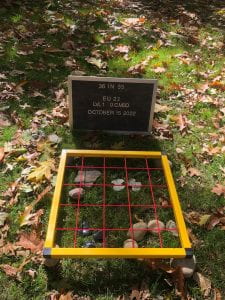
 Another station outside was led by first-year graduate student Emma, who presented on the importance of mapping in archaeology. Using a poster, worksheet, and mini grid, children and adults alike could practice mapping. She instructed people on why we do mapping, what we map, why we prefer mapping over taking photographs, what we need to include on our maps, and why we use a grid system when mapping. She stated that it is our goal as archaeologists to record as much information as possible, and that because digging is destructive, we need an accurate mapping of our excavation units before we continue to dig artifacts up, as mapping provides context for the location of the recovered cultural resources, as well as a record of any features and stratigraphy in the unit.
Another station outside was led by first-year graduate student Emma, who presented on the importance of mapping in archaeology. Using a poster, worksheet, and mini grid, children and adults alike could practice mapping. She instructed people on why we do mapping, what we map, why we prefer mapping over taking photographs, what we need to include on our maps, and why we use a grid system when mapping. She stated that it is our goal as archaeologists to record as much information as possible, and that because digging is destructive, we need an accurate mapping of our excavation units before we continue to dig artifacts up, as mapping provides context for the location of the recovered cultural resources, as well as a record of any features and stratigraphy in the unit.
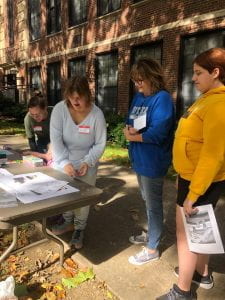 First-year graduate student Liz also had a set-up outside, where she was teaching people about stratigraphy. She used different colored, kinetic sand and small rocks and pottery sherds in a clear box to mimic the stratigraphic layers archaeologist encounter as they dig down into the soils. She also had a bright and colorful poster, along with a matching worksheet that allowed visitors to learn more about stratigraphy, and what various layers can look like.
First-year graduate student Liz also had a set-up outside, where she was teaching people about stratigraphy. She used different colored, kinetic sand and small rocks and pottery sherds in a clear box to mimic the stratigraphic layers archaeologist encounter as they dig down into the soils. She also had a bright and colorful poster, along with a matching worksheet that allowed visitors to learn more about stratigraphy, and what various layers can look like.
 Also outside was Susanne Haney from PennDOT (Pennsylvania Department of Transportation) and the Westmoreland Archaeological Society Chapter #23 of the Society for Pennsylvania Archaeology. She was doing flint knapping and instructing others on how to do it as well. She also had brought many examples of prehistoric artifacts, many of which sh
Also outside was Susanne Haney from PennDOT (Pennsylvania Department of Transportation) and the Westmoreland Archaeological Society Chapter #23 of the Society for Pennsylvania Archaeology. She was doing flint knapping and instructing others on how to do it as well. She also had brought many examples of prehistoric artifacts, many of which sh e had made herself. A few things she showcased were an atlatl, stone tools and pendants, a nutting stone, flint ridge chert, obsidian, red catlinite from Wisconsin that can be used to make pipes, bifaces and scrapers, a tiny, dried gourd to represent the ones used by ancient Native American to hold up fishing nets in the water, and cordage made from plant materials such as basswood bark and dogbane, and also deer sinew fibers.
e had made herself. A few things she showcased were an atlatl, stone tools and pendants, a nutting stone, flint ridge chert, obsidian, red catlinite from Wisconsin that can be used to make pipes, bifaces and scrapers, a tiny, dried gourd to represent the ones used by ancient Native American to hold up fishing nets in the water, and cordage made from plant materials such as basswood bark and dogbane, and also deer sinew fibers.

When you entered McElhaney Hall, on one side you could enter the Children’s room. This room contained many activities to keep kids entertained, but also to introduce them to the world or archaeology. From ceramic analysis to coloring worksheets, paleolithic “cave” paintings, making wampum bead bracelets, and more, kids were guided by volunteer Heather and first-year graduate student Kahlan through a range of archaeological topics. This will hopefully serve as a foundational step for the younger generation in their archaeological journey.
The next room over held our section on Zooarchaeology, led by first-year graduate student Emily and second-year graduate student Zach. Emily discussed hominins and showcased how skulls changed over the c o
o urse of millions of years to bring us to the skulls of the modern-day humans. She also laid out stone tools that correlate to each skull and displayed a replica of footprints made by the primitive species Australopithecus afarensis, or “Lucy,” from 3.6 million years ago. There was even a worksheet for students to match the pictures of the skull replicas to their corresponding names and date ranges. Zach was in charge of animal bones and skeletons and used a display that had visitors match the animal to an individual bone, which included a bear skull amongst others. He also displayed whole turtle shells, cat, fish, and frog skeletons, shells, and a pig head that had many visitors intrigued and curious to know what it was!
urse of millions of years to bring us to the skulls of the modern-day humans. She also laid out stone tools that correlate to each skull and displayed a replica of footprints made by the primitive species Australopithecus afarensis, or “Lucy,” from 3.6 million years ago. There was even a worksheet for students to match the pictures of the skull replicas to their corresponding names and date ranges. Zach was in charge of animal bones and skeletons and used a display that had visitors match the animal to an individual bone, which included a bear skull amongst others. He also displayed whole turtle shells, cat, fish, and frog skeletons, shells, and a pig head that had many visitors intrigued and curious to know what it was!
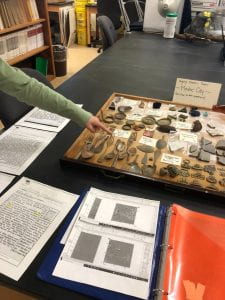 In the same room, third-year graduate student Ashley was displaying her ongoing master’s thesis on Modoc City. She exhibited many of the historic artifacts that she has excavated from the site, which dates from 1873 to around 1890, although these were just a few from the 9+ whole boxes Ashely has filled. She also laid out several newspaper articles describing life in the city during its time of occupation. Some of the historical artifacts presented include a broken frozen charlotte, makeup containers or compacts, utensils, suspender clasps, bells, an original Dr. Scholl’s foot-eazer, glass and ceramic pieces, pocket watch components, dresser handles, boot heels, and even a mint container!
In the same room, third-year graduate student Ashley was displaying her ongoing master’s thesis on Modoc City. She exhibited many of the historic artifacts that she has excavated from the site, which dates from 1873 to around 1890, although these were just a few from the 9+ whole boxes Ashely has filled. She also laid out several newspaper articles describing life in the city during its time of occupation. Some of the historical artifacts presented include a broken frozen charlotte, makeup containers or compacts, utensils, suspender clasps, bells, an original Dr. Scholl’s foot-eazer, glass and ceramic pieces, pocket watch components, dresser handles, boot heels, and even a mint container!
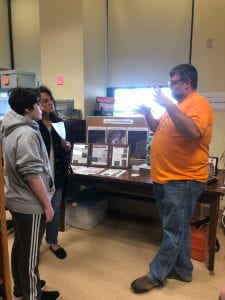 Second-year graduate students Amanda and Emma, along with
Second-year graduate students Amanda and Emma, along with 
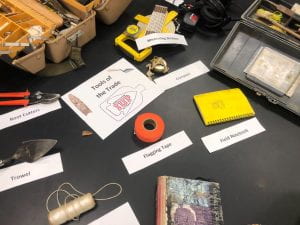 Dr. Chadwick, a professor here at IUP, were also in this room, discussing the PHAST (PennDOT Highway Archaeological Survey Team) program, what goes inside a dig kit, and what some of the geophysical tools used in archaeology are and how they operation. These such geophysical instruments included metal detectors and ground-penetrating radar.
Dr. Chadwick, a professor here at IUP, were also in this room, discussing the PHAST (PennDOT Highway Archaeological Survey Team) program, what goes inside a dig kit, and what some of the geophysical tools used in archaeology are and how they operation. These such geophysical instruments included metal detectors and ground-penetrating radar.
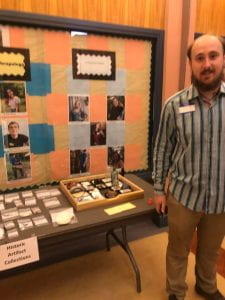 Back in the hallway second-year graduate student Luke was displaying a historic artifacts collection. He explained that historic sites are those that date between European contact in America to our modern day. As part of his graduate assistantship, he takes care of the legacy collections here at IUP. Some of the artifacts he works with are from excavations done 50 years ago at Hanna’s Town, a 1700s site, so he has been going through them, organizing them, and putting them in archival bags for storage, to keep up to new standards of preservation and to prevent deterioration and disorganization. He also displayed a historic artifact learning collection of things we see often at historic sites for visitors to observe and interact with.
Back in the hallway second-year graduate student Luke was displaying a historic artifacts collection. He explained that historic sites are those that date between European contact in America to our modern day. As part of his graduate assistantship, he takes care of the legacy collections here at IUP. Some of the artifacts he works with are from excavations done 50 years ago at Hanna’s Town, a 1700s site, so he has been going through them, organizing them, and putting them in archival bags for storage, to keep up to new standards of preservation and to prevent deterioration and disorganization. He also displayed a historic artifact learning collection of things we see often at historic sites for visitors to observe and interact with.

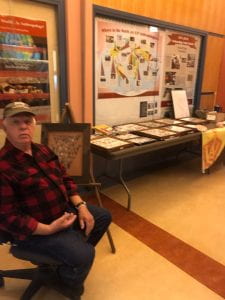 There was also a prehistoric artifact collection, hosted by Westmoreland Archaeological Society Chapter #23 of the Society for Pennsylvania Archaeology. Many of the artifacts on display were recovered by Sidney Guest, a member of the chapter, as well as from the group themselves. Their exhibited collection included, petrified wood, a wide assortment of bifaces and projectile points, a large nutting stone, and even some t
There was also a prehistoric artifact collection, hosted by Westmoreland Archaeological Society Chapter #23 of the Society for Pennsylvania Archaeology. Many of the artifacts on display were recovered by Sidney Guest, a member of the chapter, as well as from the group themselves. Their exhibited collection included, petrified wood, a wide assortment of bifaces and projectile points, a large nutting stone, and even some t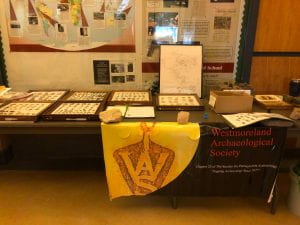 ools archaeologists use in the field, to name a few. Mr. Guest explained that some of the artifacts were from excavations at a rock shelter near Derry, PA. He also stated that their chapter had just sent many boxes of artifacts to the State Museum after finishing up a dig they had been conducting over the past 16 years at a Monongahela village site with two overlapping village components. The Consul site (36WM100) included 49 houses and produced over 19 radiocarbon/AMS dates, with one of the villages dating to the Early Monongahela period around A.D. 1350, and the other to the Middle Monongahela period around A.D. 1450. We are so grateful that the Westmoreland Archaeological Society were able to come out and join us!
ools archaeologists use in the field, to name a few. Mr. Guest explained that some of the artifacts were from excavations at a rock shelter near Derry, PA. He also stated that their chapter had just sent many boxes of artifacts to the State Museum after finishing up a dig they had been conducting over the past 16 years at a Monongahela village site with two overlapping village components. The Consul site (36WM100) included 49 houses and produced over 19 radiocarbon/AMS dates, with one of the villages dating to the Early Monongahela period around A.D. 1350, and the other to the Middle Monongahela period around A.D. 1450. We are so grateful that the Westmoreland Archaeological Society were able to come out and join us!
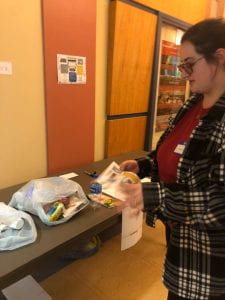 First-year graduate student Laura was next to the prehistoric artifacts set-up, and her station was about garbology, the study of modern humans through analyzing modern-day waste, and its connection to archaeology. She noted that archaeologists excavate landfills and utilize ethnographic interview methods to understand how humans create and dispose of waste, to answer questions about waste disposal, and to help apply these interpretations in other settings and studies. Laura also included a QR code on her handout that links students to “A Tale of Garbage” by Ian McTaggart for more information, and she provided a take home activity worksheet that had visitors keep track of their trash disposal habits to see what this can tell them about their trash practices. She also engaged with visitors by having them participate in an activity where they had to determine which bag of trash came from which room in the house, which simulated how trash can lead to inferences about people.
First-year graduate student Laura was next to the prehistoric artifacts set-up, and her station was about garbology, the study of modern humans through analyzing modern-day waste, and its connection to archaeology. She noted that archaeologists excavate landfills and utilize ethnographic interview methods to understand how humans create and dispose of waste, to answer questions about waste disposal, and to help apply these interpretations in other settings and studies. Laura also included a QR code on her handout that links students to “A Tale of Garbage” by Ian McTaggart for more information, and she provided a take home activity worksheet that had visitors keep track of their trash disposal habits to see what this can tell them about their trash practices. She also engaged with visitors by having them participate in an activity where they had to determine which bag of trash came from which room in the house, which simulated how trash can lead to inferences about people.
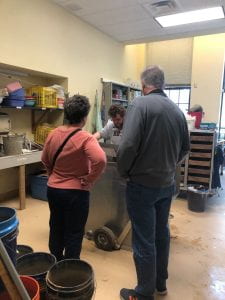 In the final room inside, we had second-year graduate student Jacob in the floatation lab teaching and instructing people about how and why we use the laboratory technique of archaeological flotation. The floatation machine is used to recover tiny artifacts and plant remains from soil samples, which visitors got to experience up close.
In the final room inside, we had second-year graduate student Jacob in the floatation lab teaching and instructing people about how and why we use the laboratory technique of archaeological flotation. The floatation machine is used to recover tiny artifacts and plant remains from soil samples, which visitors got to experience up close.

And finally, as people exited our Archaeology Day event, they passed by our Exit table, manned by first-year graduate student Wesley. He was passing out free posters and information on stewardship through fliers. He was also having those who left voluntarily fill out a paper with questions about their experience. We had great feedback, one visitor commented, “It was fun and interesting😊,” and many people noted their favorite activities.
A huge thank you to everyone who came out and supported this open house, and to those who put everything together, Dr. Andrea Palmiotto and second-year graduate student Mikala Hardie! We will most definitely be hosting this event next year, so please join us again, or for the first time, in 2023!

I finally found the information I was looking for on your blog. You can’t be happier than this. I want to say thank you so much for posting this. Please continue to post good comments.
Best Taxi Service In Jaipur
I finally found the information I was looking for on your blog. You can’t be happier than this. I want to say thank you so much for posting this. Please continue to post good comments.
Website Design Services In Jaipur
Hey, thank you!!! I was seeking particular information for a long time. Good Luck!
Free vashikaran specialist astrologer
Daily I visit most of the web pages to get new stuff. But here I got something unique and informative.
Free Astrology consultancy services in India
Daily I visit most of the web pages to get new stuff. But here I got something unique and informative.
Get My Boyfriend Girlfriend Back By Astrology
Real estate CRM software also helps you master key metrics by providing visually appealing charts and smarter reports. With these, you can see where you’re falling short of revenue goals.This custom real estate crm software development also helps you manage and segment leads based on their source, budget, and zip code. It also helps you manage your lead sources and referrals more effectively. Lastly, real estate CRM software can automate data processing and analytics.
Another important factor to consider is the price. If you are on a tight budget, consider using an affordable, subscription-based CRM. The cost will vary depending on the features and functionality you need. For example, Microsoft Dynamics CRM offers major updates every two years. It’s also limited to real estate agents, and you may end up having to create custom connectors for the different systems you’re using. In addition, it’s important to read reviews and contact client references before purchasing a CRM.
I just wanted to mention I adore it every time visiting your excellent post! Very effective and very correct. Loving your blog. It is refreshing to read this.
Love problem solutions
Thanks for sharing this information. I really like your blog post very much. You have really shared an informative and interesting blog post with people.
Get Vashikaran Love Solution Aghori Baba ji
Your website contains such useful information. Appreciate your written skills and your blog.
Public Limited Company Registration
This post is really astounding one! I was delighted to read this, very much useful. Many thanks
Disturbed Marriage Life Solutions
I read your Post and impressed your written skills you have such Great through.
Bring My Lost Lover Back
I check your blog again and again. Best of luck for your new article.
Husband Wife Dispute Relationship Problem Solution
This is such a nice article. Thank you so much for sharing your knowledge. Keep it up.
Best Sexologist Doctor in Jaipur